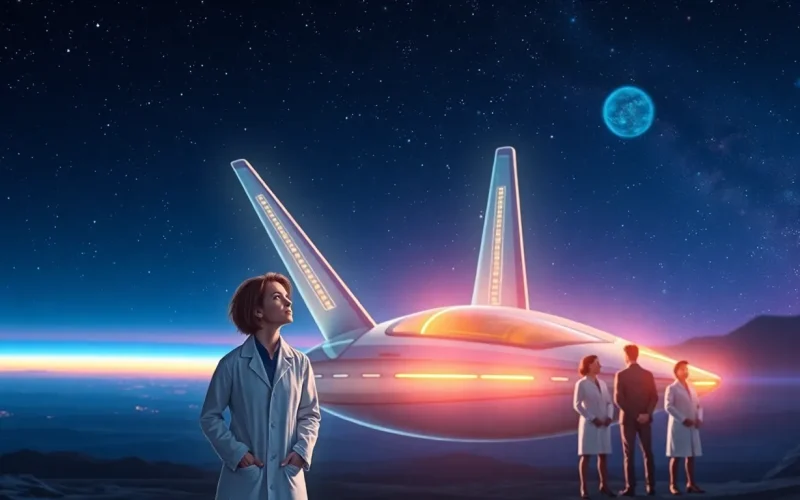Table of Contents
ToggleImagine zipping through the cosmos, sipping a cosmic cocktail while dodging asteroids like a space cowboy. Interstellar travel isn’t just the stuff of science fiction; it’s the tantalizing frontier of human exploration. With advances in technology and a sprinkle of imagination, the dream of visiting distant stars might not be as far-fetched as it seems.
As scientists unravel the mysteries of the universe, they’re also igniting a spark of curiosity about what lies beyond our solar system. From warp drives to wormholes, the possibilities are as vast as the galaxies themselves. So, buckle up and get ready to explore the quirks, challenges, and potential of interstellar travel. Who knows? One day, you might just find yourself on a vacation to a planet with three suns and a bar that serves drinks with a side of stardust.
Overview Of Interstellar Travel
Interstellar travel refers to movement between stars, encompassing vast distances and complex physics. Current technology doesn’t permit such journeys, yet theories abound. Concepts like warp drives promise to bend space, allowing faster-than-light travel. Wormholes, on the other hand, theorize shortcuts through spacetime, connecting distant points directly.
Astronomers estimate that the nearest star system, Alpha Centauri, lies about 4.37 light-years away. Reaching it with present-day spacecraft takes over 70,000 years. Research focuses on innovative propulsion systems to reduce travel time significantly. Concepts include solar sails, which harness sunlight for propulsion, and fusion drives, utilizing nuclear fusion for thrust.
Mission designs reflect ambitions for interstellar probes, like the Breakthrough Starshot initiative. This project aims to send tiny spacecraft to Alpha Centauri, achieving speeds up to 20 percent of light-speed. Challenges persist in energy sources and materials capable of withstanding extreme conditions during travel.
Understanding cosmic phenomena also plays a crucial role in planning. Cosmic radiation poses risks to travelers, as does microgravity over extended periods. Life support systems must support human needs for years, considering food, air, and waste management.
Collaboration among scientists, engineers, and visionaries drives progress. International space agencies and private companies increasingly invest in breakthrough technologies. Their efforts could transform interstellar travel from a concept into a plausible reality within centuries.
The Science Behind Interstellar Travel

Interstellar travel captivates scientists and enthusiasts alike, relying on complex physics and advanced technology. Several theoretical concepts offer intriguing possibilities for achieving such extraordinary journeys.
Theoretical Concepts
Warp drives and wormholes represent two of the most discussed theories. Warp drives could bend space-time, allowing spacecraft to travel faster than light without violating relativity. Wormholes, on the other hand, might create shortcuts through space, connecting distant regions instantaneously. These theories stem from Einstein’s general theory of relativity, highlighting the intricate nature of space-time. Though practical implementation remains elusive, researchers continue to explore these concepts, aiming to unlock methods for interstellar movement.
Current Technologies
Current technologies focus on innovative propulsion systems to expedite space travel. Solar sails harness sunlight for movement, using large, reflective surfaces to propel small spacecraft. Fusion drives could produce thrust by fusing hydrogen atoms, yielding high speeds while using minimal fuel. Initiatives like Breakthrough Starshot aim to develop tiny spacecraft equipped with light sails, potentially reaching 20 percent of light-speed. Such advancements showcase the commitment to transforming theoretical concepts into practical tools for future interstellar missions.
Challenges Of Interstellar Travel
Interstellar travel presents substantial challenges that scientists and researchers must address. Two primary obstacles include distance and time, alongside energy requirements.
Distance and Time
Distances between stars are immense. Alpha Centauri, the closest star system, lies approximately 4.37 light-years away. Present spacecraft require over 70,000 years to reach this destination. Reaching other stars would take even longer. The vastness of space complicates travel feasibility. Time dilation concepts, derived from Einstein’s theory, suggest time moves differently at high speeds, yet these theories remain theoretical. Continuous advancements in propulsion technology may offer solutions. Developing systems that significantly reduce travel time constitutes a significant focus of current research.
Energy Requirements
Energy demands for interstellar travel are staggering. Traditional fuel sources cannot support the energy needs for such long journeys. For instance, achieving even a fraction of light-speed requires vast amounts of energy. Some proposed methods include harnessing solar energy through solar sails. Fusion drives offer another potential avenue, utilizing hydrogen fusion to produce thrust. Significant breakthroughs in energy generation and storage technologies are essential. Researchers aim to create lightweight and efficient energy systems for sustained missions. Addressing these energy challenges directly influences the viability of interstellar travel.
Future Prospects Of Interstellar Travel
Interstellar travel holds immense potential, promising exploration beyond current boundaries. Researchers focus on creating missions that might one day reach other star systems.
Upcoming Missions
Breakthrough Starshot is one noteworthy initiative. This ambitious project aims to launch small spacecraft toward Alpha Centauri at 20 percent of light-speed. A solar sail powered by laser beams from Earth would propel these tiny probes, allowing them to reach their destination within 20 years. Other projects also explore concepts like the Interstellar Probe, which targets the heliosphere’s outer boundary to collect valuable data. Each mission contributes to understanding the feasibility of interstellar journeys.
Potential Discoveries
Exploration of neighboring star systems could unveil astonishing discoveries. Identifying exoplanets within habitable zones might lead to the existence of extraterrestrial life. Scientific analysis of atmospheres, chemical compositions, and potential biosignatures could revolutionize humanity’s understanding of life in the universe. Additionally, studying cosmic phenomena and gravitational interactions at a broader scale will enhance knowledge of physics. As missions progress, they may uncover resources or conditions supportive of human colonization, reshaping perspectives on our place in the cosmos.
Interstellar travel represents a thrilling frontier for humanity. As technology advances and theoretical concepts evolve, the dream of reaching distant stars becomes more tangible. Initiatives like Breakthrough Starshot and the Interstellar Probe showcase the commitment to pushing boundaries and exploring the unknown.
While significant challenges remain, the potential discoveries awaiting in other star systems could transform our understanding of the universe. The journey toward interstellar exploration is not just about reaching new destinations; it’s about expanding humanity’s horizons and redefining its place in the cosmos. As researchers continue to innovate, the possibilities for future generations are boundless.





